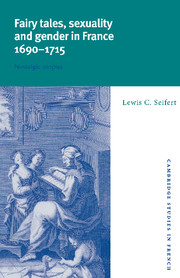Book contents
- Front Matter
- Contents
- Acknowledgments
- Note on translations and quotations
- Introduction
- Part I MARVELOUS STORYTELLING
- Chapter 1 Marvelous realities: toward an understanding of the merveilleux
- Chapter 2 Reading (and) the ironies of the marvelous
- Chapter 3 The marvelous in context: the place of the contes de fées in late seventeenth-century France
- Part II MARVELOUS DESIRES
- Afterword
- Notes
- Selected bibliography
- Index
- Cambridge Studies in French
Chapter 2 - Reading (and) the ironies of the marvelous
Published online by Cambridge University Press: 22 September 2009
- Front Matter
- Contents
- Acknowledgments
- Note on translations and quotations
- Introduction
- Part I MARVELOUS STORYTELLING
- Chapter 1 Marvelous realities: toward an understanding of the merveilleux
- Chapter 2 Reading (and) the ironies of the marvelous
- Chapter 3 The marvelous in context: the place of the contes de fées in late seventeenth-century France
- Part II MARVELOUS DESIRES
- Afterword
- Notes
- Selected bibliography
- Index
- Cambridge Studies in French
Summary
What does the marvelous mean? How is one to interpret the marvelous? These questions are at the heart of many studies devoted to folk- and fairy tales. From the numerous folkloristic approaches to structuralist methodologies and from traditional literary history to psychoanalytic perspectives, the question of how to interpret the marvelous is a central and often contentious issue. Yet, common to all these critical tendencies is the assumption that the marvelous presents itself as meaning “otherwise,” as meaning something other than what it designates literally. Of course, from this perspective, marvelous literature is no different from any other literary text in that it can be read simultaneously in two different ways – referentially (as referring to its own fictional context) and figuratively (as meaning something other than its reference and, thus, requiring interpretation). Within the seventeenth-century fairy tales, it is the marvelous that highlights the possibility of figurative readings. As such, the marvelous becomes an emphatic sign of the readability, that is, the figurability or interpretability, of the text.
In chapter 1, I argued that the links between the marvelous and vraisemblance are highly ambivalent: the merveilleux can both uphold and disrupt the social outlook that literary plausibility came to signify in seventeenth-century France. To discern this ambivalence, however, is to acknowledge at least tacitly the readability of this corpus and, specifically, the marvelous that characterizes it.
- Type
- Chapter
- Information
- Fairy Tales, Sexuality, and Gender in France, 1690–1715Nostalgic Utopias, pp. 43 - 58Publisher: Cambridge University PressPrint publication year: 1996



